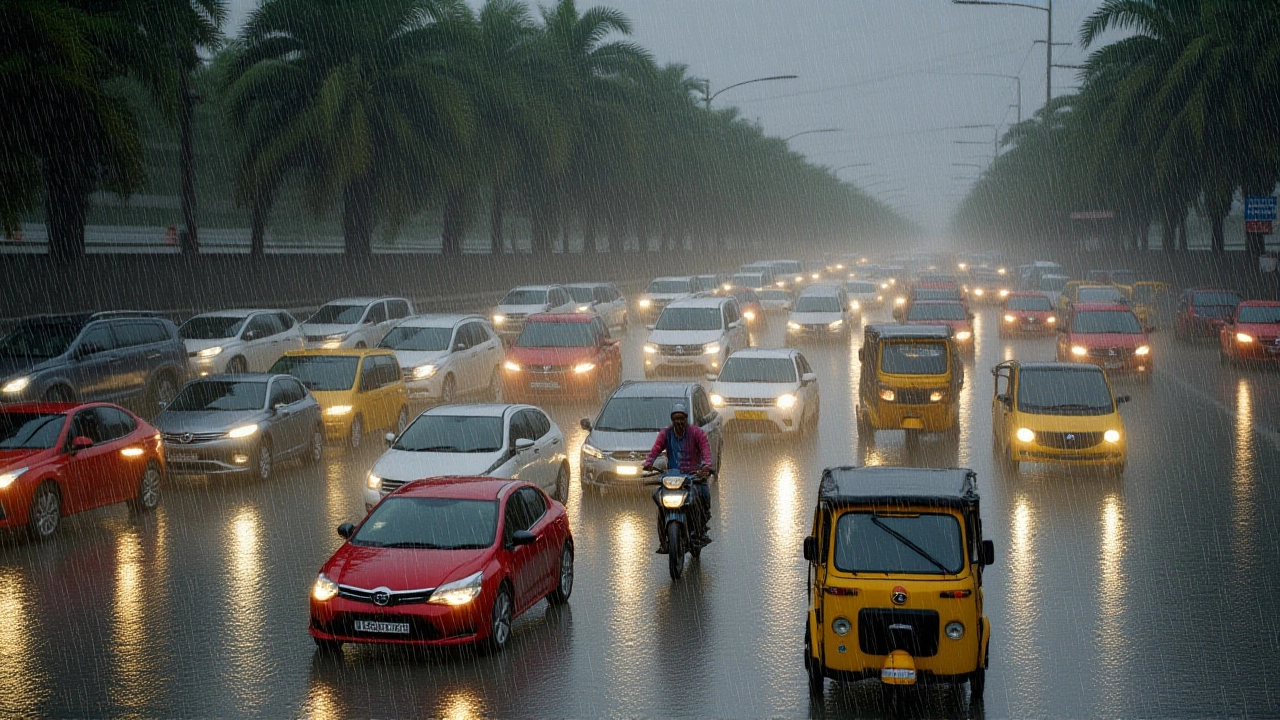When Chennai International Airport got caught in a sudden downpour on Sunday, October 5, 2025, the sky over the city turned into a chaotic bottleneck for air traffic. The disruption began around 3:00 PM IST, as a deep depression over the Bay of Bengal unleashed squalls with wind gusts of 45‑55 km/h and rainfall peaking at 85 mm per hour. S. Venkatesan, the airport’s manager, later confirmed the emergency protocol was triggered at 3:25 PM, but passengers were left scrambling for answers.
Weather Event Overview
The Regional Meteorological Centre (RMC) in Chennai, part of the India Meteorological Department, had issued a yellow thunderstorm alert at 12:45 PM. The alert warned of intense convection and possible squall lines, yet airline operations centers say the warning never reached them in time. Dr. M. Mohapatra, director of the RMC, told Hindusthan Samachar that communication gaps are being investigated.
By the time the rain hit its apex between 3:15 PM and 4:45 PM, visibility at the runway dropped below the minimum required for safe landings, forcing air traffic controllers to hold inbound aircraft in a holding pattern over the city.
Flight Disruptions and Delays
In total, 22 flights – 12 arrivals and 10 departures – were affected, stranding roughly 2,850 passengers. The most dramatic diversion involved a IndiGo flight IX-628 from Colombo, which carried exactly 149 travelers. The aircraft was rerouted to Kempegowda International Airport in Bengaluru after controllers judged Chennai’s runway unsafe.
- Inbound flights that spent over 45 minutes circling included AI‑427 (Delhi), 6E‑325 (Mumbai), IX‑142 (Kochi), UK‑812 (Goa), IT‑824 (Madurai), and 6E‑219 (Tiruchirappalli).
- Outbound delays hit routes to Abu Dhabi (EY‑242), Muscat (WY‑613), Delhi (AI‑245), Mumbai (6E‑204), Hyderabad (S2‑822), Bengaluru (6E‑208), Thoothukudi (TR‑277) and Shirdi (SG‑904).
Average delay for arrivals was about 2 hours 15 minutes, while departures lagged by roughly 1 hour 50 minutes. The longest hold recorded was 92 minutes for a flight from Goa, which finally touched down once the rain eased.

Passenger Experiences and Airport Response
Travelers described the scene as a mix of frustration and anxiety. Rajesh Kumar, a 42‑year‑old software engineer heading to Delhi, told reporters, “We were left completely in the dark for nearly 90 minutes with no official announcements about why our flight was delayed or when it might depart.” Similar complaints echoed across social media, with many criticizing the lack of real‑time updates from airport authorities.
Terminal crowding surged as the international departure lounge hit 95 % capacity and the domestic area reached 87 % during the 4:00 PM‑6:00 PM window. Airport staff set up temporary seating zones, but the makeshift arrangements did little to soothe the growing impatience.
At 5:30 PM, S. Venkatesan addressed the press, stating, “Passenger safety remains our top priority. We coordinated with Air Traffic Control to manage airspace congestion while activating our emergency response protocol.” Yet, many argued that the statement came after the worst of the chaos had already unfolded.
Operational Review and Future Precautions
The Airport Authority of India (AAI) Regional Office in Chennai later released an operational review. It highlighted three key takeaways:
- Improved dissemination of meteorological alerts to airlines and ground handlers.
- Installation of advanced low‑visibility landing systems to reduce reliance on weather‑dependent runway closures.
- Enhanced passenger communication protocols, including dedicated text‑messaging alerts during emergencies.
The review noted that the last delayed departure – 6E‑204 to Mumbai – finally left the apron at 7:20 PM, and normal operations resumed by 8:00 PM. However, connecting flights continued to feel ripple effects well into midnight.

Background: Chennai’s Weather Patterns and Airport Resilience
Chennai, located on the eastern coast of Tamil Nadu, experiences a tropical wet‑dry climate. October marks the tail end of the Southwest Monsoon, a period notorious for sudden thunderstorms and squall lines. Historical data from the IMD shows that between 2010 and 2020, the city faced 27 similar weather‑related disruptions at its airport.
In response, the airport has invested in runway drainage upgrades and a state‑of‑the‑art weather radar system. Nonetheless, the October 2025 event exposed gaps in coordination between meteorological services and airline operations, prompting calls for a unified communication platform.
Frequently Asked Questions
How many passengers were affected by the October 5 disruption?
Approximately 2,850 travelers on 22 flights experienced delays, diversions or prolonged holding patterns during the heavy rain event.
What caused the flight diversions and delays?
A deep depression over the Bay of Bengal generated squalls with wind speeds up to 55 km/h and rainfall of 85 mm per hour, reducing runway visibility and prompting safety‑first diversions.
Did the airport issue any warnings to passengers?
Airport officials admitted communication was lacking; the first public statement came after most flights had already been delayed, sparking criticism from travelers.
What steps are being taken to prevent a repeat?
The AAI plans to upgrade low‑visibility landing aids, improve real‑time weather alert distribution to airlines, and launch a passenger‑focused alert system for future disruptions.
How did the weather event compare to past incidents?
While Chennai has seen several monsoon‑related delays, the October 2025 squall line was unusually intense, causing the largest single‑day disruption since the 2018 November thunderstorm episode.
